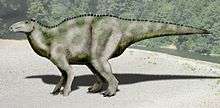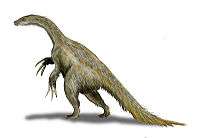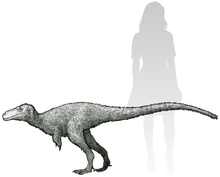Moreno Hill Formation
The Moreno Hill Formation is a geological formation in New Mexico whose strata date back to the Late Cretaceous. Dinosaur remains are among the fossils that have been recovered from the formation.[1]
| Moreno Hill Formation Stratigraphic range: Turonian | |
|---|---|
| Type | Geological formation |
| Lithology | |
| Primary | Sandstone, Shale |
| Other | Siltstone, Coal |
| Location | |
| Region | |
| Country | |
Vertebrate paleofauna
Dinosaurs
| Dinosaurs of the Moreno Hill Formation | ||||
|---|---|---|---|---|
| Taxa | Presence | Description | Images | |
|
Genus:
|
A basal hadrosauromorph.[2] |
| ||
|
Genus:
|
A therizinosaur.[3] "Teeth, fragmentary skull bones, cervical and other vertebrae, scapula, partial forelimb and hindlimb."[4] | |||
|
Genus
|
A tyrannosauroid based on a partial skull and skeleton.[5] | |||
|
Genus:
|
A ceratopsian.[6] "Partial cranial and postcranial materials of five individuals."[7] | |||
|
Clade
|
||||
gollark: Is HelloBoi becoming more coherent?
gollark: > apiorusteoforms<@309787486278909952> * apiorustaceoforms
gollark: No this is actually bad.
gollark: Ah, Tux1! Heavserver?
gollark: Recent experiments with apiolectromagnetic induction have determined that it is closer to seven.
See also
- List of dinosaur-bearing rock formations
References
- Weishampel, David B; et al. (2004). "Dinosaur distribution (Late Cretaceous, North America)." In: Weishampel, David B.; Dodson, Peter; and Osmólska, Halszka (eds.): The Dinosauria, 2nd, Berkeley: University of California Press. Pp. 574-588. ISBN 0-520-24209-2.
- McDonald, A.T., Wolfe, D.G., and Kirkland, J.I. (2006). "On a hadrosauromorph (Dinosauria: Onithopoda) from the Moreno Hill Formation (Cretaceous, Turonian) of New Mexico." Pp. 277-280 in Lucas, S.G. and Sullivan, R.M. (eds.), Late Cretaceous vertebrates from the Western Interior. New Mexico Museum of Natural History and Science Bulletin, 35.
- Kirkland, J.I., and Wolfe, D.G. (2001). "First definitive therizinosaurid (Dinosauria: Theropoda) from North America." Journal of Vertebrate Paleontology, 21(3): 410-414.
- "Table 7.1," in Weishampel, et al. (2004). Page 152.
- Wolfe, Douglas G.; McDonald, Andrew T.; Kirkland, James I.; Turner, Alan H.; Smith, Nathan D.; Brusatte, Stephen L.; Loewen, Mark A.; Denton, Robert K.; Nesbitt, Sterling J. (May 6, 2019). "A mid-Cretaceous tyrannosauroid and the origin of North American end-Cretaceous dinosaur assemblages". Nature Ecology & Evolution: 1. doi:10.1038/s41559-019-0888-0 – via www.nature.com.
- Wolfe, D.G. and Kirkland, J.I. (1998). "Zuniceratops christopheri n. gen. & n. sp., a ceratopsian dinosaur from the Moreno Hill Formation (Cretaceous, Turonian) of west-central New Mexico." Pp. 303-317 in Lucas, S.G., Kirkland, J.I., Estep, J.W. (eds.), Lower and Middle Cretaceous Terrestrial Ecosystems: New Mexico Museum of Natural History and Science, Bulletin, 14.
- "Table 22.1," in Weishampel, et al. (2004). Page 480.
- Sterling J. Nesbitt; Robert K. Denton Jr; Mark A. Loewen; Stephen L. Brusatte; Nathan D. Smith; Alan H. Turner; James I. Kirkland; Andrew T. McDonald; Douglas G. Wolfe (2019). "Supplementary information for: A mid-Cretaceous tyrannosauroid and the origin of North American end-Cretaceous dinosaur assemblages" (PDF). Nature Ecology & Evolution. 3 (6): 892–899. doi:10.1038/s41559-019-0888-0. PMID 31061476.
This article is issued from Wikipedia. The text is licensed under Creative Commons - Attribution - Sharealike. Additional terms may apply for the media files.



